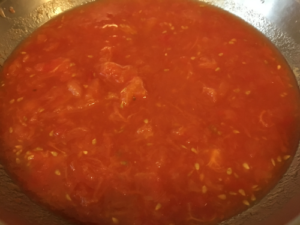The Baghdadi Jewish Dish that was Created in Mumbai and Kolkata
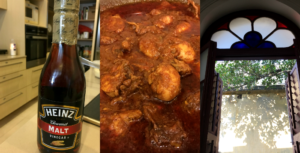
the taste was sour and sweet, a smooth, compelling aroma filled my mouth and nose, the texture was silky, a depth in it. i’d never tasted a chicken dish like this before. i’d never tasted anything like this before.
the first time i had chicken chitannee, i certainly didn’t think of aurangzeb, or the british, or dawud pasha, the last mamluk ruler of baghdad. the dense gravy, mixed with fluffy white gobindobhog rice wouldn’t brook any thinking. the tender yet a little chewy chicken with that tangy sweetness in every strand, why would anyone bother to ponder or pause while that was still on the plate?
the chicken chitannee had been made by a lady who had a thing for both cooking and feeding people; she absolutely delighted in it. on that afternoon in 1984, she had come with the express purpose of treating my family and me to this dish she particularly enjoyed making. her son was a good friend of mine and she’d decided to cook her specialty for us, it was as simple as that. in a couple of years, the lady with her great sense of taste, texture, and exactly how much to hammis, would become my mother in law. but what’s that got to do with dawud pasha or the others?
my husband and i are both indians, however, we come from different communities. i am bengali, my family has lived in india’s eastern state of bengal for countless generations. during the partition of india, bengal was divided; what remained in india is known to this day as west bengal; forever not quite complete, hinting at a counterpart, an “east” somewhere, although the map no longer has any record of such a place. the other part went to pakistan and was called east pakistan, later to become bangladesh. bengal was always a large province, there was perhaps even a difference in the culture of purbo bongo or east bengal, and poschim bongo, west bengal; but for centuries it was one land. 1947 changed all that.
the people of the east have seen upheaval; many of them have had to leave their ancestral land and travel to the west, in search of a new home. they’ve had to make a place among those who were not quite prepared for this migration. but we in the west, we’ve stayed put, settled, quite comfortable where we were, never persecuted or compelled to leave. if we left west bengal, it was out of choice: for a job, to study, on a transfer.
my husband is a baghdadi jew; clearly not from india, originally. his great grandparents moved to calcutta from baghdad. that would make him a third-generation or fourth-generation indian depending on how you define the term. i’d never met a jewish person before, so for a long time, i had no idea about all the different jewish communities. i thought the baghdadis were also sephardic jews. but no, not quite. not really.
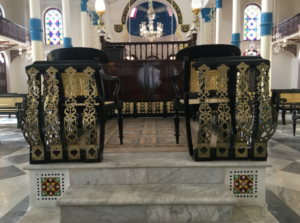
over the years, as i tried to make a mean chicken chitannee (precise instructions from mother in law often sought), i got to know a bit about the baghdadi jews: their history, their food, their beautiful synagogues, their sometimes quirky ways, their attempt to hold on to what they considered their own even when means were meagre. i became aware perhaps for the first time about the nature of displacement. of how it hews and etches you, how it’s always a part of you, makes you who you are.
when you leave what you think of as home, not because you necessarily wanted to, but it was what you had to do, and go to a brand new environment, your story gets so much more complex than what you’d ever planned for. there’s sour in it, there’s also sweet in it, and there’s that intriguing aroma, a spice or a combination of spices, which you can’t quite identify. and that’s fine, that gives it its richness, its depth, its gravitas.
it all sort of started with the death of aurangzeb, i think. when the last strong, if not great, mughal emperor died in 1707, the inevitable power struggles began. the mughals, the marathas, the nizam and the nawab, and whoever else was in the fray, tried to seize the moment, but they didn’t quite make it. seeing the absence of a central, formidable force, the british reckoned it was a good time to move into hindustan. enough of hanging about along the shores, setting up factories and forts, at the mercy of the whims and firmans of the mughal or his minion. they’d been waiting since jehangir’s time. well, they had to wait just fifty more years.
in 1757, the young nawab of bengal, siraj ud daulah, attacked the british east india company’s fort william in calcutta, displeased with the way the company was conducting its business. one thing led to another. clive arrived in bengal, warren hastings’ languages teacher nabakrishna deb had some good ideas, the inordinately rich jagat seths were willing to help, siraj’s commander mir jafar could be bought, some other bright sparks pitched in, clive sussed victory. the tutor, the banker, the commander, the company men, and a few others threw in lots of treachery and greed, added a squeeze of duplicity and bigotry, and served up a fateful defeat at palashi.
siraj lost, the british won, the first step in the colonizaion of india was taken.
 the taste of power, a bit like chitannee, makes you want more. after bengal, the company went on a conquering spree across india. calcutta became its capital, the most fabulous city of the east. who’d believe it used to be three little hamlets by the hooghly river once. sutanati, gobindopur, and kalikata, which were bought by the englishman job charnock from the zamindar, the land lord, in 1690, when the british were granted the freedom to trade in bengal in exchange for an annual fee.
the taste of power, a bit like chitannee, makes you want more. after bengal, the company went on a conquering spree across india. calcutta became its capital, the most fabulous city of the east. who’d believe it used to be three little hamlets by the hooghly river once. sutanati, gobindopur, and kalikata, which were bought by the englishman job charnock from the zamindar, the land lord, in 1690, when the british were granted the freedom to trade in bengal in exchange for an annual fee.
while in india, a company came to rule a land, in another grand city, a group of people were facing unexpected trouble.
it was the jews of iraq. many of them lived in and around the great metropolis baghdad. they’d been here for a long long time. almost two and a half thousand year ago their ancestors had been exiled here from jerusalem, when this was ancient babylonia still. in time, babylonia had become home. they’d lived and traded and worshipped and married and flourished and created a whole way of life here. the babylonian talmud had been written here. learned rabbis and thinkers lived here. when jews were persecuted all over europe, even in jerusalem, they were secure in this stretch of land. didn’t matter who ruled, what new games of statecraft were afoot, the jews belonged here.
baghdad was built in the eighth century by the abbasid caliphate and soon became a centre of culture, learning, and commerce. jews and muslims lived in harmony in the city. they spoke the same language; the jews let a smattering of hebrew words add flavour to their arabic. they cooked similar food as well, the sweet and sour taste was a shared preference.
the ottomans conquered mesopotamia in the mid 1500s. by the late 1700s, the pashas or governors of baghdad were appointing eminent jewish men as treasurers. the jews were happy in baghdad and its neighbouring regions. what could possibly go wrong?
ask any baghadadi jew about their history, and soon enough you’ll hear of one dawud pasha: the man almost single-handedly responsible for making the jews of iraq think of leaving home. once again.
dawud pasha was appointed governor of baghdad in 1816. from all accounts, the georgian born mamluk was not a nice man to deal with. he started harassing the jews. it was not classic religious persecution, from what i’ve heard; it was more about interference in business and money matters. life became very difficult under him.
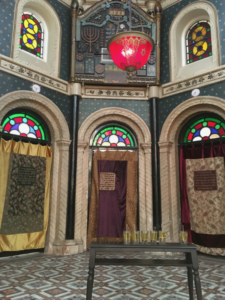
british influence in iraq and along the maritime trade route to the east was growing at the time. their rule in india was already quite established. jews started to leave baghdad and move to india. the british i guess were not averse to the idea. after all, no harm in accommodating an enterprising trading community that would be grateful for the assurance of safe stay, and could be used to further british mercantile interests as well.
david sassoon, whose father was once the treasurer of baghdad as was he himself, relocated to bombay (now known as mumbai). his business expanded rapidly. a sizeable jewish settlement grew there. but it was calcutta, the most significant city at the time, the commercial capital where many communities congregated, which became home to the largest community of jews from iraq. over six thousand of them lived here once. there were several synagogues. the early ones were modest, but reflecting the growing prosperity of the immigrants from baghdad, the ones that were built later were far more elaborate and stately.
the jewish bakery, nahoum’s, opened in 1902… even today, the shop is always crowded, it’s a major feat to elbow your way in, get someone’s attention, and buy the almond macaroon or baklava or christmas cake you desire on that day. yes, the most well known jewish bakery in calcutta made the best christmas cake. it still does. time brings change, the city is now called kolkata, the british have gone, and only a handful of baghdadi jews remain, but come december, the queues for the season’s best cake will start.
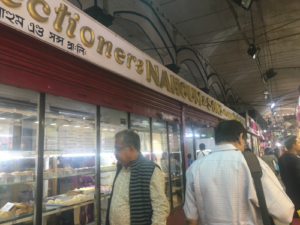
it was in india that the jews of iraq came to be known as baghdadis, after the city most of them were from. the anglicized baghdadian jews was also used. but baghdadi gained currency; it in fact refers to jewish immigrants from all over the middle east; from syria, afghanistan, persia, and other places in the region, besides iraq.
the baghdadis were traditional and religious people. there were so many dietary necessities as observant kosher jews, there were worries and concerns of all kinds; about faith, about family, about the future; it must have been quite a challenge to keep it all together in an all new, unfamiliar place. and they must have missed the taste of baghdad: the various dishes jewish matriarchs had developed in iraq, over time, and cooked with care, fussing over every detail. food is all about connection, i feel sometimes. it feeds not just a physical hunger but something far deeper, within us… familiar tastes and aromas seem to centre us. like a ballast that holds us steady as we sail through life, which has its share of storm and turbulence.
as the baghdadis adapted to their new world, they began wearing western clothes, no longer the robes and long dresses they’d worn back home. the younger generation didn’t want to learn arabic. they’d rather speak english, or even bengali and hindi when they needed to. their language of millennia was gone very quickly, only a few words of it remained. home, dress, language, one by one, they went.
i understood later that my mother in law belonged to a line of tough women, who in effect kept a community’s sense of identity alive through the simple act of cooking and taking pride in it. mahashahs, kubbahs, hamim, halba, makalah… they kept generations anchored. safe.
 in time, a little bit of kolkata, of mumbai, started to get into the baghdadis. in the baghdadi kitchen, experiments got going. turmeric, ginger, chilli, garam masala, coriander leaf, bay leaf, potato… women played with the new ingredients they found. they spoke to their indian friends, the bengalis, sindhis, gujaratis, and others; they added the tastes and smells they liked to iraqi favourites. local vegetables were thrown into sweet and sour stews and stuffed for mahashas; the hamim that was cooked overnight, got a dash of turmeric and ginger; the aloo makalah came into being; apparently the jumping potato that is almost as ubiquitous as dawud pasha in conversations with baghdadi jews, originated in kolkata.
in time, a little bit of kolkata, of mumbai, started to get into the baghdadis. in the baghdadi kitchen, experiments got going. turmeric, ginger, chilli, garam masala, coriander leaf, bay leaf, potato… women played with the new ingredients they found. they spoke to their indian friends, the bengalis, sindhis, gujaratis, and others; they added the tastes and smells they liked to iraqi favourites. local vegetables were thrown into sweet and sour stews and stuffed for mahashas; the hamim that was cooked overnight, got a dash of turmeric and ginger; the aloo makalah came into being; apparently the jumping potato that is almost as ubiquitous as dawud pasha in conversations with baghdadi jews, originated in kolkata.
and the chicken chitannee.
it was in india that this redolent dish was created. chitannee comes from chutney i guess. so a chutney of chicken. to the usual iraqi sweet and sour taste base, plenty of indian spices were added; and onions, tomatoes, vinegar or tamarind, and sugar. first a whole lot of onion had to be fried, then you had to hammis it with the chicken. read somewhere, in mumbai, they would use goat meat, but since there was no shohet or ritual slaughterer in kolkata after a point, they switched to chicken. my husband and his brother remember an old man called ezra, who used to sit near the chicken stalls in new market every day. you bought a chicken and went over to him, and for a small some of money, he slaughtered it in keeping with the kosher laws.
hammis is the technique of slowly frying something to let the water evaporate, the texture become firm and juicy, and the aromas release fully, blend well together. there’s no rushing a chitannee; after the onion, chicken, and spices have been stirred and fried till they’re done, you add the vinegar – my mother in law liked mohan’s malt vinegar – and a little sugar. and right at the end, she’d bestow the final touch. which changed everything.

i have seen many chicken chitannee recipes by now, from singapore, from mumbai, and other places where baghdadi jews have lived, but no one uses this ingredient or technique. when my mother in law told me that the last thing to add would be roasted and ground coriander seeds and cumin seeds, and you turned off the fire then mixed it in, i was taken aback. such a bengali flavour in a dish so baghdadi? bhaja moshla or roasted spice is something we are very fond of. you can roast and grind cumin, coriander, aniseed, cardamom, clove, cinnamon, dry red chilli, five spice… always good to keep handy. they infuse a burst of taste in almost anything. the combination of roast cumin and coriander is beautiful, and really bengali… can’t imagine aloor dom or ghughni without it. that the chicken chitannee got its distinctive dark brown look and coruscant flavour from this, i’d have never guessed. i was pleased though when i found out. there was a difference however, for us it’s usually more of the roasted cumin and less of coriander, but my mother in law always said, put more of the coriander.
there are very few homes in kolkata or mumbai where chitannee is made any longer. but the memories live, the taste buds yearn, and in kitchens in far flung places, a daughter, a grand daughter, a grandson or a daughter in law tries to make a chicken chitannee just like mother’s, grandmother’s, or mother in law’s.

chicken chitannee | recipe
1 1/2 chicken cut into pieces
10 big red onions thinly sliced
8 large tomatoes
3/4 bay leaves
15 cloves
15 green cardamoms
2 2-inch sticks of cinnamon
2 1/2 tbsp ginger paste
1 1/2 tbsp garlic paste
1 1/2 tsp kashmiri chilli powder
1 1/2 tsp red chilli powder, less if you prefer a milder spike of chilli
1 flat tsp turmeric powder
1 1/3 cup malt vinegar
2 large tsp sugar
2 heaped tbsp roasted coriander powder
1 1/2 heaped tbsp roasted cumin powder
at least 3/4 cup oil, you might need more
salt to taste
cooking time: takes about an hour and twenty minutes.
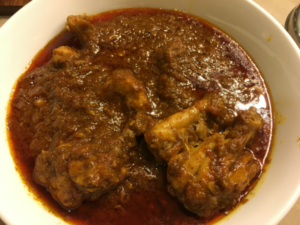
heat the oil in a wok. add bay leaves and cinnamon, let the aroma release, then add all the onion and start frying.
fifteen minutes or so later, or as the onion starts going transparent and pinkish, throw in the cloves and cardamoms. remember to crack open the skin of the cardamoms a little, and break the top of the cloves while you add them. keep stirring and frying. hammis the onion, as my mother in law would say.
after another ten to fifteen minutes, when the onion is about to change colour, looking drier, there’s a little more sizzle in the sound, add the chicken. ideally, salt the chicken and wash it off earlier. add salt later only if needed. stir the chicken and keep frying on medium heat.
the chicken will begin to brown, the onions will look more cooked, now add the the ginger and garlic pastes. always more ginger, less garlic. keep stirring, turning, and slow frying on medium heat.
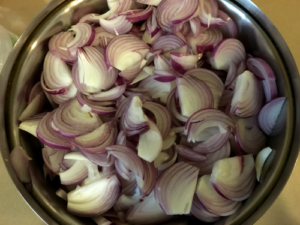
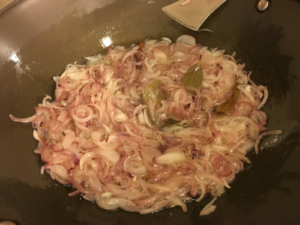
a bit later, add the two chilli powders and the turmeric powder. the quantity of chilli powder mentioned here gives you a rather hot chitannee. you can put less chilli powder if you like. you can use a mix of kashmiri chilli and paprika too, so you have the colour but not too much heat.
you can quarter the tomatoes and throw them in at this point, and keep frying. after a while, lower the flame, cover the wok and let the tomatoes get tender, then take off the lid and cook.
or.
blanch and peel the tomatoes, mash or blend them and add it to the chitannee. this time, i felt there was a lot of pulp and the chicken would get too soft while cooking the tomatoes, so i put the pulp in a pot and let it sit on the fire for a while, then added it.
keep stirring and cooking.
when the meat is done, add the vinegar and sugar, and cook for a few minutes. getting the right proportion of sour and sweet is important. it’s not a tame, mild taste you’re looking for. the tang should hit you a little, make you suck your breath in. the sweet should be subdued. as the tastes settle, i find the sweetness gets more pronounced, so it’s best to add a little extra vinegar.
sprinkle the roasted coriander and cumin powders, turn off the fire, mix the powders well into the chitannee. the colour will turn dark reddish brown, and the flavour will make you sigh.
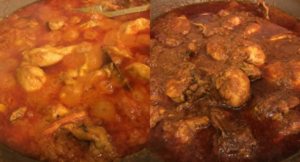
before adding the roasted coriander/cumin powder and after
note: chitannee is like a pickle, it tastes much better once the vinegar and the flavours have had time to soak in. it’s best eaten the day after you cook. in fact, the oil keeps it from going bad, and you can leave it covered outside (if the weather’s not too warm), and have it over two or three days. instead of vinegar, you can use tamarind, but i prefer malt vinegar.
roasting | coriander and cumin
put a few table spoons of coriander seeds on a skillet or flat heavy bottom pan and and start roasting it on medium heat. Keep turning and stirring the seeds. don’t leave unattended, keep an eye on coriander, the seeds can start to burn. when a nice fragrance starts to waft, and the seeds turn a little darker, take off the fire. cool. grind. put in an air tight container. if you want to keep it for a while, store in the freezer.
follow the same method for cumin seeds. the seeds will go a little darker than the coriander. keep moving the seeds, especially as they start changing colour.
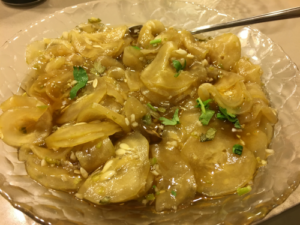
to serve | white rice and zalata
my mother in law would insist on the small grained, fragrant, fine gobindobhog rice to go with the chitannee. nothing fancy, just cook it plain and serve hot.
on the side, she’d serve zalata: a baghdadi cucumber salad. peel the cucumber, cut in thin circles, sprinkle salt and leave aside for half an hour. boil some malt vinegar with a little sugar, say a cup of vinegar with two teaspoons of sugar. when it cools down, add finely chopped garlic, ginger, green chillies, coriander leaf, mint leaf (optional). squeeze the cucumber gently, let the excess water drip off, then put it into the vinegar dressing and mix well. serve after a few hours or even the next day.
[ original here ]

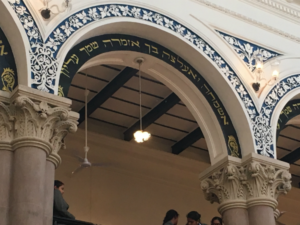
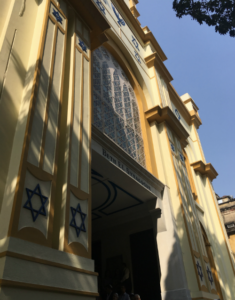
shots of maghen david and beth el synagogue in kolkata, which were recently restored and rededicated on 17 decemeber 2018. after a long time, many kolkata baghdadi jews returned from all over the world to be part of the ceremonies.
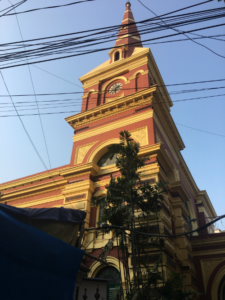
Category: Baghdadi in India, Food, Heritage


